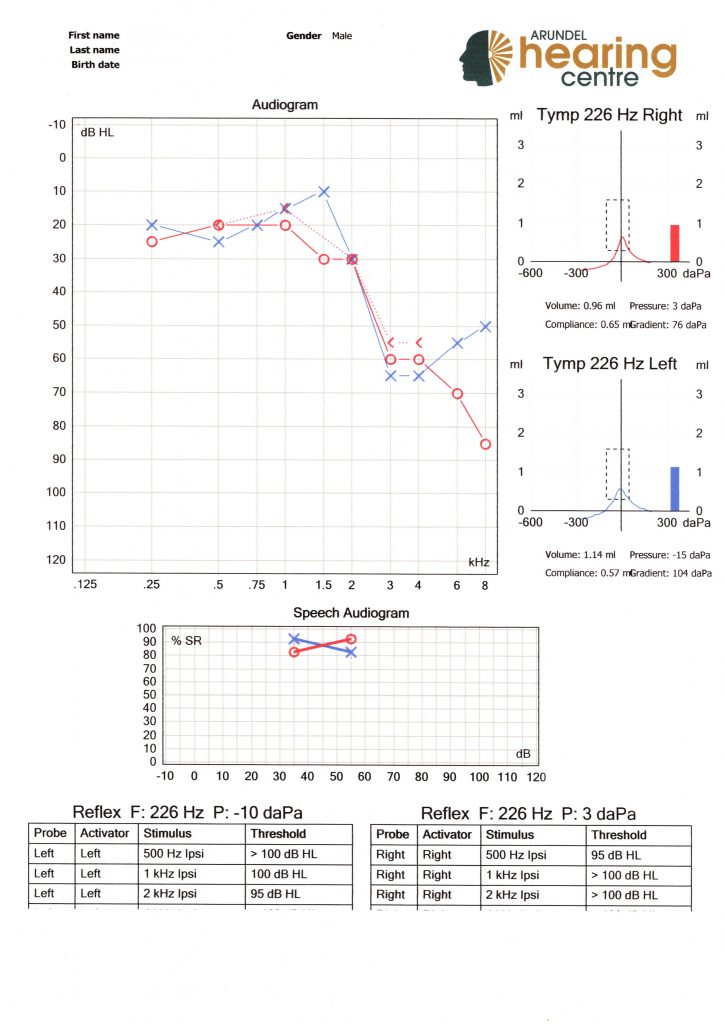COMMON TYPES OF HEARING LOSS:
Hearing loss is usually separated into two types:
Conductive hearing loss is caused by a physical or mechanical problem preventing the flow of sound waves into and through the ear. For example wax in the ear canal or fluid in the middle ear can create a blockage, preventing sound from getting into the inner part of the ear. These mechanical or physical problems can often be medically or surgically corrected
Sensorineural hearing loss is caused by damage or deterioration to the hair cells or nerve endings in the inner ear. For example damage from noise exposure or deterioration as a result of getting older.
The symptoms for either of these types of hearing loss can be in one (monaural) or both (binaural) ears and can be progressive (happen over a period of time) or sudden. The degree of loss can also vary from very mild to severe or profound.
Whether it is a permanent hearing loss or only temporary will vary between individuals and needs to be assessed by a qualified clinician.
SUDDEN HEARING LOSS:
Sudden Hearing Loss can happen immediately or over a period of a few days; it can result from infections or viruses like mumps, measles, and flu or other unknown causes:
- A head injury for example falling and hitting your head on the pavement, may lead to an immediate loss of hearing.
- Sudden Hearing Loss can range from being quite severe to even a total loss of hearing.
If you suspect a Sudden Hearing Loss has occurred it is very important to act quickly and see a specialist either through your local doctor or Accident and Emergency at your closest hospital. Immediate treatment is vital.
GRADUAL (PROGRESSIVE) HEARING LOSS:
Often undiagnosed or diagnosed late because it may not impact a person’s life severely until it is in its later stages. Hearing tests can diagnose this and solutions are at hand, so it’s important to try to catch the problem early.
Common causes of gradual hearing loss include:
- Genetics
- Aging – especially for those over 65
- Exposure to loud noises – from work-tools, household objects, headsets or concert halls, for instance
- Build up of earwax
- Abnormal tissue growth – tumours, for instance
- Other conditions such as Meniere’s Disease
AUDIOGRAM:
This is called an audiogram. The numbers across the bottom are the frequencies audible to a healthy human ear. As you look at the page, the numbers to the right are the higher frequencies and those to the left are the deeper, base tones.
Down the side is a measurement of the strength of the signal in decibels – really loud down at the bottom, really soft at the top.
There are 2 lines on the audiogram; a red one with circles and a blue one with crosses. The red is your right ear and the blue is your left ear.
Normal hearing would see both these lines somewhere above 20dB on this graph so you can see this audiogram indicates a bilateral hearing loss ranging from mild to severe in the higher frequencies.
With hearing devices, we are attempting to push all these higher frequency thresholds back above 20dB to recreate 2 nice flat lines that more accurately reflect what your cochlear did when it worked as it should.
TINNITUS:
Tinnitus is the perception of ringing in the ears when there is no sound actually present.
Tinnitus is not a disease, but a condition that can result from a wide range of underlying causes: neurological damage (multiple sclerosis), ear infections, oxidative stress, foreign objects in the ear, nasal allergies that prevent (or induce) fluid drain, wax build-up and exposure to loud sounds.
Tinnitus may be an accompaniment of Sensorineural Hearing Loss or Congenital Hearing Loss, or it may be observed as a side effect of certain medications (ototoxic tinnitus). However, the most common cause is Noise-Induced Hearing Loss. Temporary Tinnitus can occur when we are exposed to nonpermanent noise or suffer from ear infections. Eventually fluid in the ear passes and the ringing stops. Wax blockages in the outer canal also cause Tinnitus.
Common Symptoms
- You hear ringing or strange sounds in your ears. Tinnitus has been described as high pitched and screechy, low pitched and pulsing, locusts and cicadas.
- Tinnitus is usually loudest when it is quiet, as you can focus on the fact that it is there.
- Tinnitus can become so annoying that it affects sleep and is distracting.
- Tinnitus should always be checked by a doctor.
MENIERE’S DISEASE:
Meniere’s Disease is a disorder of the inner ear that can affect hearing and balance to a varying degree. It is characterized by episodes of vertigo, low-pitched tinnitus, and hearing loss. The hearing loss is fluctuating rather than permanent, meaning that it comes and goes, alternating between ears for some time, then becomes permanent with no return to normal function. We have perilymph and endolymph fluid inside the inner ear. This fluid swells and applies pressure to the inner ear and semicircular canals. This can cause a range of severe symptoms for people.
Managing Meniere’s Disease
If you feel this combination of symptoms is relevant to you then speak to a qualified clinician. They can advise you if a consultation with an Ear Nose and Throat specialist is recommended.
Although Meniere’s disease cannot be cured there are many ways of effectively managing the symptoms. Hearing aids can be very successful in alleviating the difficulties associated with a Meniere’s type hearing loss. In fact a capable clinician can program an appropriate hearing device to be flexible enough to accommodate fluctuations in hearing loss.

